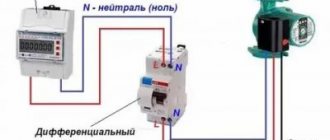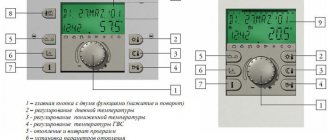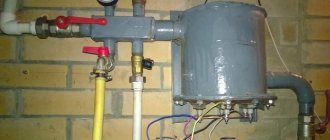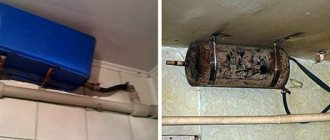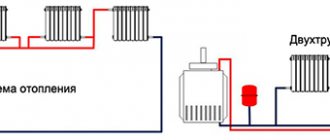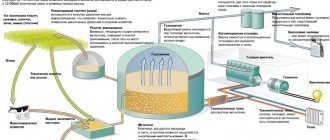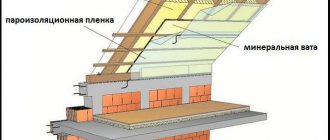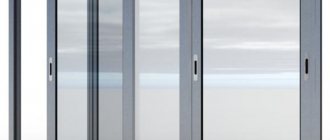Perhaps every owner of a private home is faced with the problem of installing a heating system. There is a reliable modern solution - automatic home heating ! True, many do not understand the meaning of a given phrase. Therefore, in this article we will talk about it. Obviously, the installation is designed to simplify human life! Thanks to it, it is much more convenient to control the heating. Automation has a number of other advantages, such as automatic regulation of the degree of heat, and therefore less personal time. However, not many people trust this type of heating, preferring to regulate it themselves.
The word “automation” itself refers to a set of devices that regulate any process automatically, that is, not manually. The advantage is that the unit is almost completely error-free, control is more precise, and the functionality is a treasure trove of additions.
What automatic settings are there?
Currently, the market offers consumers a wide selection of control devices. Therefore, you need to know what automation systems for home heating systems generally exist, and what to give preference to.
Room thermostat
According to installation criteria, there are:
- Wired thermostats. The advantage of this type is the ability to supply power up to approximately 50 meters via wires.
- Wireless thermostats. The advantage is that it is not necessary to create holes for the wires. However, they have a significant drawback - reinforced concrete walls reduce the signal power.
According to functionality they are distinguished:
- Simple thermostats. They retain the desired level of warmth.
- Programmable thermostats. Such devices are capable of setting a certain number of degrees for a whole week in advance (the period depends on the model) with maximum accuracy down to seconds. The advantages also include cost savings due to weekly programming.
Thermostats are also distinguished:
- Electronic thermostats. The kit contains three components: temperature sensor, signal transmitter, relay. The main advantage of the device is the maximum accuracy of the equipment. Don't forget ease of use.
- Mechanical thermostats. The basis of the devices is the ability to change properties under the influence of temperature levels. Due to temperature changes in the gas membrane, a circuit is closed or opened, causing certain mechanisms to work.
- Electromechanical thermostats. The mechanism of the device is much simpler than an electronic one. The main element is the relay. The node looks like a tube, which is filled with a special substance that reacts to temperature. If the boiler heats up, the substance expands; similarly, when the boiler cools, the substance contracts. And the drive, dependent on the substance, regulates the temperature thanks to an electrical circuit.
Connection can be made to:
- Kotlu;
- To the pump;
- Servo drive;
Thermal head
This is a thermostatic element that, under the influence of the external environment, slightly opens or closes the radiator. An inexpensive type of automation for heating a home. A significant advantage is that the thermal head is very convenient for local heating, and there are also significant cost savings. Of the minuses: firstly, the adjustment occurs according to standards consisting of abstract numbers, not degrees. Secondly, the sensor measures the degree of heat around the installation, but not the room, which reduces the accuracy of the device.
Weather-compensated automation
The design of weather-dependent automation for heating a house is simple: as the weather outside decreases, the temperature of the coolant increases. However, a weather-dependent installation has a very significant drawback - the system sometimes does not have time to adapt to the temperature, and, therefore, the effect is delayed. The especially mentioned disadvantage manifests itself if an addition is connected - heated floors. The disadvantages include the fact that the devices do not operate entirely correctly, approximately, so the change is noticeable only during seasonal climate changes. It is worth noting that the prices for the unit are relatively high. But the units will be very convenient in production, large-scale houses (over 500 square meters).
Conclusion
Automation of the heating system makes it possible to get rid of constant monitoring of the temperature in the boiler and allows you to set the necessary comfortable thermal conditions in each room. To achieve such goals, thermal valves and room regulators are used, both separately and in combination.
In the latter case, savings on the operation of the heating system are more significant. The video in the article will provide an opportunity to find additional information on the above topic.
Did you like the article? Subscribe to our Yandex.Zen channel
Automation for radiators
- Using a thermal head with a valve; (Described above)
- Climate control;
Consists of a thermoelectric actuator, controller, sensor. Fully automatic installation for heating a house with the possibility of remote control. Climate control - automatic control using sensors with many additions. The advantages include: firstly, control is available centrally, remotely (from mobile devices), secondly, the ability to connect to a smart home system, thirdly, setting a schedule.
The mechanism is designed as follows: a special drive connected to the controller is installed on each radiator. Sensors are connected to the controller. When the temperature changes, the sensors react and then send a signal to the controller, which regulates the valve.
Combined heating system control
- Technical support
- Articles
- Combined heating system control
#warm floor #built-in heating #automation of engineering systems
A combined system means a design solution in which the room is heated with both water heated floors and radiators. Such a system is mainly used in cases where underfloor heating alone cannot compensate for the calculated heat loss of the room, even at the maximum permissible coolant temperature. The fact is that in accordance with clause 6.4.9. SP 60.13330.2016, the temperature of the floor surface in rooms with constant occupancy should not exceed 26 °C. If we take into account that the average heat transfer coefficient of the floor is 10.8 m2/°C • W, and the average design air temperature in the room is 20 °C, then from the surface of the heated floor it is possible to obtain a specific heat flux not exceeding 10.8 (26 -20) = 64.8 W/m2.
Having installed a combined heating system at home, we are immediately faced with the question: how to adjust it?
The classic method of controlling a heating system is to use electronic room thermostats in conjunction with electrothermal actuators installed on the heating manifold. The principle of this control is simple: the user sets the desired room temperature on the room thermostat, for example 20 °C. If the actual air temperature exceeds the set one, the thermostat is in the “off” position and the servo drive shuts off the coolant supply to the radiator or floor heating loop. When the actual air temperature drops below the set value by more than the hysteresis value (0.5 °C), the thermostat switches to the “on” position. The servos open and the coolant flow begins to circulate again. Hysteresis is necessary for the correct operation of the thermostat. Otherwise, when the required value of 20 °C is reached, the thermostat would begin to constantly turn on and off, that is, it would enter the “bouncing” mode.
The operation of a heated floor control system using a conventional room thermostat is shown in Fig. 1
.
Rice. 1. Control of the heating system using a thermostat and servo drive
With the control of a conventional heating system, everything is quite clear, but what about when using a combined system?
Of course, you can simultaneously send a signal from the room thermostat to turn on or off both the heated floor and radiators. However, this type of regulation is not always convenient. The fact is that during the heating season there are so-called off-season periods - autumn and spring. During these periods, a situation arises in which heating must operate at only 10-15% of its design capacity. At this time, the heat flow from heated floors is quite sufficient to heat the premises. When the outside air temperature drops, the radiator heating system should already be connected to compensate for heat loss. That is, with a combined heating system, the heating control circuit must also be combined. An example of such a scheme is shown in Fig. 2
.
Rice. 2. Double-circuit control of a combined heating system
As can be seen from the figure, the thermostat already controls not one, but two heating circuits using an additional relay. In the settings menu of such a thermostat, the dT
, which defines the temperature zone above the setpoint at which only one relay is turned on.
In the example shown in Fig.
2 , this value is
dT
= 3 °C.
Let's take a closer look at the operating principle of this device. Two values are set on the thermostat: the first is the setting of the thermostat itself (20 °C), and the second value is dT
, which is adjusted once and is applicable for any set value.
If the actual air temperature in the room is below the set point, this means that the room is cold, and the heating system must be turned on at 100% to warm it up. This mode is indicated in the figure as zone 1
. In this case, the thermostat turns on both relays, thereby providing heating with a warm floor and radiator. This situation occurs, as a rule, during peak periods of cold, when the minimum temperature outside is established.
When the temperature rises above the set point (20 + 0.5 °C = 20.5 °C), the relay controlling the radiator is turned off. Thus, at the optimal temperature range, the radiator will be turned off, but the warm floor will remain on to ensure comfort in the room. If the air temperature begins to decrease, the thermostat turns on the relay again and the radiator heating works again. However, if the air temperature continues to rise (the underfloor heating power is sufficient), then when the air is heated by dT (3 °C), the thermostat also turns off the underfloor heating circuit. After the system cools down and the internal air temperature drops below 23 ° C, the thermostat turns on the heated floor and, if its power is insufficient and the temperature continues to drop, then the radiator heating also turns on. This gives us a temperature range of 20°C to 23°C, in which our system operates with maximum efficiency.
To carry out such regulation, VALTEC, based on the existing chronothermostat VT.AC709, has developed a dual-circuit chronothermostat VT.AC711 ( Fig. 3
And
4
).
Rice. 3. Front panel of dual-circuit chronothermostat VT.AC711
Rice. 4. Rear panel of dual-circuit chronothermostat VT.AC711
As can be seen from Fig. 4
, an additional relay appeared in the device, while the entire range of functionality of the VT.AC709 chronothermostat remained the same.
A separate item for setting the dT value has appeared in the advanced settings menu ( Fig. 5
).
Rice. 5. dT parameter setting menu
This default value is 3 °C, but it is recommended to set it based on the characteristics of a particular system and its thermal inertia.
Thus, we have a full-fledged dual-circuit regulator that can control our heating system both manually and according to daily and weekly schedules.
Connection diagrams for various types of servos are shown in Fig. 6
.
Rice. 6. Servo drive connection diagrams
Please note that when connecting servos in accordance with Fig. 6
it is necessary to install a jumper between terminals
1
and
3
.
The drives can also be connected according to the diagram shown in Fig.
7 .
Rice. 7. Alternative servo drive connection diagram
The dual-circuit control system described in the article can also be used in an apartment building, if thermostats are used in conjunction with servo drives instead of traditional thermostatic heads. It is recommended to set such an operating algorithm in the case when there is a need to control two heating devices located in the same room. That is, when the set value is reached, one heating device is first turned off, and then, if the internal air temperature continues to rise, the second device is also turned off. This allows not only to save thermal energy, but also to maintain more comfortable conditions for residents.
Author: Bobrov A.A., automation engineer
Print the article: Controlling a combined heating system
“twist
© Copyright holder Vesta Regions LLC, 2010 All copyrights reserved. When copying an article, a link to the copyright holder and/or to the website www.valtec.ru is required.
Automation for coal boiler
The capabilities of the devices are quite wide. Often, sets of heating devices include: a computer that controls the device, a fan or an air turbine.
The advantage of equipment equipped with automation for heating a private home is considered to be a huge saving of precious minutes and money. After all, innovative long-burning boilers can do almost all the work for you - they can work without human intervention for quite a long time - up to approximately 48 hours! The home owner only needs to set the desired degree level, and the device will carry out the actions independently. In addition, you can set a timer for temperature mode. That is, for example, if the owner of the home leaves it for a certain amount of time, the minimum temperature regime will be maintained. When the tenant arrives, the timer will go off and the home will begin to warm up again to the desired temperature - without human intervention! So, upon arrival, your accommodation will be comfortable and warm.
It is important to note that boilers with automation have become so developed that they are able to independently carry out diagnostics - a safety check, which is a very significant plus.
Boilers with automatic feed
Today they are considered the most efficient installation - after all, the efficiency reaches 80-85%! This unit will definitely provide home comfort. The fuel is poured into the bunker and from there it is supplied automatically to the combustion chamber. There is also an addition that allows you to empty the ash pan automatically - without human intervention. The process of installing boilers is a very painstaking work, so saving is not worth it for your benefit.
Is there a need for remote heating control?
In general, remote control has many advantages, which include creating additional comfort. Thus, you can prepare for your arrival or the arrival of guests in advance and heat the house to the desired temperature.
In addition, there are other reasons for choosing remote heating of a country house :
- Significant savings on heating costs, as it becomes possible to turn on the economy mode when there are no residents.
- Long service life of the heating system due to significant reduction in loads.
In addition, it should be taken into account that the development trend for engineering systems is their integration into a single network, which makes it possible to reduce the overall costs of maintaining a house. Thus, a security system for heating, if there are free control channels and appropriate software, can additionally perform other functions, for example, turn on or off watering in a greenhouse.
Heating remote control elements
Tip: The successful functioning of the entire house is achieved through the coordinated operation of all engineering systems in a single network.
The safety group for the heating system, which currently monitors the pressure value, can be additionally equipped with appropriate sensors and actuators, and the fire safety of the heating systems can be ensured by such a system.
Well, we should not forget that this approach is part of the ideology of creating a “smart home”, which implies the further development of all engineering systems.
Remote control of various engineering systems, including heating, must be considered as their further development. The purpose of its implementation is to ensure ease of use and create living conditions that best suit individual needs and current circumstances.
For more information about remote control of heating in a country house, watch the video:
Automation for pump
Regulates the operation of the system, controlling many functions, such as, for example, pressure, water distribution.
For normal operation, the following components are required: a manifold that provides water supply, a relay that controls the pump, a pressure gauge that measures pressure, a dry-running sensor that prevents the device from overheating if the water runs out.
All automation responsible for the pump is divided into several models, based on the time of creation:
First generation automation;
The first simplest water supply design. Used to solve simple problems when it is necessary to provide a room with a source of water. It consists of three components: a dry running sensor, a hydraulic accumulator that performs the task of accumulating water and contains a membrane, and a relay that controls water pressure. It usually does not cause any difficulties during installation, since the system completely eliminates complex electrical circuits. The mechanism is also extremely easy: the order is cyclical—when the water is completely filled, the pump turns off, then the cycle repeats.
Second generation automation
The sample differs from the previous one in that sensors have been added to the control to monitor the operation. As a result, a hydraulic accumulator is not necessary, since its function is performed by sensors. The second generation automation is not in great demand, as it is similar to the first, but is much more expensive.
Third generation automation
It is a more worthy version of its predecessors, and costs more accordingly. The unit stands out for its greatest reliability, efficiency, improved safety program, and most importantly, maximum accuracy of the device.
To maintain the device in automatic mode, a relay is installed. The mechanism is simple: when the water pressure decreases, the relay starts the system, and similarly, when the pressure increases, it stops.
Thermostat to turn the pump on or off
The most common type of automation for a pump in home heating. Mechanism: first, information is collected from the sensor, then the indicators are compared, the operation of the pump depends on this. For example, if the owner sets the mode to +60 and the hysteresis to +5, then the water must be +65 for the system to start, and for it to stop, the temperature must be +55.
Modernization of boiler equipment and replacement with new ones
If for some reason it is not possible to replace old energy-consuming boilers, they can be modernized. Installation of boiler room automation , although it requires certain costs, especially when it comes to replacing old boilers with new ones, opens up great prospects for energy saving.
Today the market offers three main types of automation:
- maintaining a comfortable temperature;
- additional fuel savings;
- providing automatic control.
When installing a private boiler room , first of all, you need to ensure that the heating system is able to provide comfortable conditions inside the house. To do this, the boiler must have external and room temperature sensors, thermostats that automatically maintain the room temperature, and, if necessary, optimal humidity . Automation of a private boiler room with room thermostats allows you to regulate the switching on and off of boilers based on the air temperature, and not the coolant temperature. The air takes longer to cool than water, which means the frequency of switching on and off decreases. Therefore, automation of a private boiler room helps to save fuel.
It would be good if the installation of boiler room automation is complemented by heat controllers, including power modulation and cascade regulators. The cascade regulator, based on the water or steam temperature, sets the number of boiler stages required for the current moment. A decrease in fuel consumption occurs with an increase in the number of stages.
And the third point is to provide the boiler room with a special control panel, which receives all the boiler room operation signals. This includes the operating mode of boilers, changes in temperature indicators of coolants, the condition of filters and pumps, and any malfunctions or accidents. Thanks to the installation of boiler room automation, full dispatching (automatic control of the boiler) is carried out. The important thing is that thanks to the remote control you can control the operation of the boiler over long distances using the Internet or telephone line.
What to choose?
Weather-compensated automation is more expensive than a system with room thermostats. Especially if the boiler is not equipped with the appropriate module from the factory. If you have a large house with a complex multi-circuit heating system, there are heated extensions and other structures on the site, then installing weather-dependent automation will be justified. In most cases, you can get by with installing room thermostats with the ability to program heating for a day or a week.
Once again the most important thing:
- Automation allows minimizing human participation in controlling the operation of the boiler.
- Controlling the air temperature - indoors and outdoors - is more effective and economical than adjusting only by coolant temperature.
- Using a thermostat, you can set a comfortable heating mode without leaving the room.
- Advanced automation can program heating cycles - for a day or a week in advance.
- Weather-compensated automation is suitable for large houses and complex heating systems.
